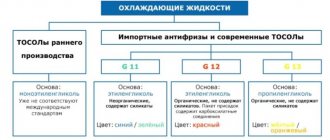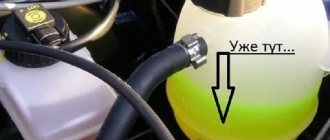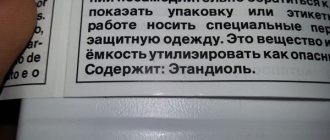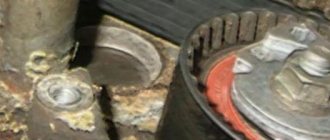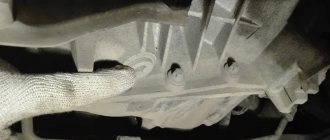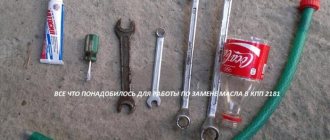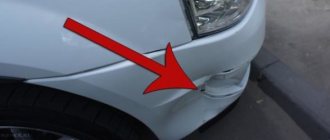The question of what Lada Largus antifreeze is poured into the system is asked by the car owner only at the moment when it is necessary to urgently add coolant to the expansion tank.
This is due to the fact that it is not recommended to mix different antifreezes with each other, as this can lead to dire consequences. Moreover, the recommendation applies not only to antifreeze of different colors, but even from different manufacturers. Most car owners are of the opinion that it is possible to mix antifreezes of the same color with each other. Alas, this is not always the case.
I'll make a small digression. Today, all antifreezes available on the market can be divided into the following classes:
- carboxylate G-12, 12+
- hybrid G-11
- Lobrid coolants G-12++ or G-13.
Do not forget also about antifreeze (or the so-called traditional antifreeze), which is well known in the Soviet Union to Lada owners.
It is allowed to mix antifreezes of the same class with each other, but it is not recommended to mix classes with each other. This can lead to unbalanced additive packages, sediment formation, or foaming of the fluid.
2271-3-7-07-03 (Copy)
We fill until the liquid begins to flow out through the air outlet fitting. We wrap the cap of the air release fitting and the cap of the expansion tank.
Let's start the engine. When the engine warms up, the outlet (lower) radiator hose should be cold for some time, and then quickly heat up, which will indicate the beginning of fluid circulation in a large circle. After waiting for the cooling system fan to turn on, stop the engine. After the engine has cooled, check the coolant level. If necessary, we bring it to normal.
Lada Largus cars are equipped with good Renault engines. But for long-term operation without breakdowns, they need high-quality cooling. And since antifreeze loses its properties over time, it needs to be changed periodically. To do this, you can contact the service or try to make the replacement yourself.
CoolStream NRC coolant originally from the factory
It came from the factory with yellow antifreeze.
After the start of production, the plant began to receive CoolStream NRC antifreeze, which was originally used to fill the cars.
This liquid fully complies with all the specifications and standards that apply to it. This liquid is produced by TECHNOFORM LLC . This company is a partner of both companies, and also occupies a leading position in the Russian market in the initial refueling of cars.
Currently, many well-known cars are filled with antifreeze from this company during production. Among them are Volvo, Citroen, KAMAZ, Fiat, Kia and others.
Antifreeze replacement regulations
The maintenance regulations for the Lada Largus car state that the antifreeze in the car must be changed every 75 thousand kilometers or after five years of operation of the car . Everything will depend on what comes first.
When replacing a fluid, it is important to choose it correctly, then there will be no problems with the car’s cooling system throughout its entire service life.
How much antifreeze is in the Largus cooling system?
The volume of antifreeze in the cooling system will depend on the make of the car and the type of engine. So, for example, Lada Kalina has 7.84 liters of antifreeze in the system, but Lada Largus will already have 5.45 liters.
Stages of replacing coolant Lada Largus
So that the new coolant lasts a long time, and does not turn into brown sludge after a couple of months. The replacement process should consist of three stages: draining, rinsing, filling. Without a flushing step, there is a possibility that the new antifreeze will quickly lose its properties.
Lada Largus cars are equipped with 1.6 liter petrol engines:
- 8 valves - K7M (VAZ-11189);
- 16 valves - K4M (VAZ-21129).
There are slight differences between them in the cooling system. On the 8 valve there is a drain hole on the engine block, but it is located in a hard-to-reach place. For this reason, not everyone will decide to drain the cylinder block, because to do this you need to remove the starter.
Coolant drain
It is more convenient to drain old antifreeze from a technological pit or on an overpass. Therefore, we drive our Lada Largus into a garage with a pit. And while the engine is cooling, we go down to unscrew the engine protection. It is secured with 6 bolts under a 10mm head.
The preparations have been completed, now we move on to draining:
- Unscrew the cap on the expansion tank (Fig. 1).
This way, almost all the antifreeze in the cooling system is drained. Now, for the best result, let's flush the system. So that fresh coolant lasts as long as possible.
Flushing the cooling system
At the washing stage, we need to decide why we are doing it. If sediment, suspensions or flakes are found in the drained liquid, then special means are needed. There are a large number of them sold and each has its own instructions to follow.
To flush the Lada Largus system from small deposits and old antifreeze, ordinary distilled water is suitable. We put all the hoses in place, fill the system through the expansion tank and close the lid.
Now you need to start the car and drive the engine until it warms up completely; you can occasionally increase the speed so that the temperature rises faster. After warming up, turn off the engine, wait for it to cool down a bit and drain the water.
Filling without air pockets
After flushing and draining as much as possible according to the instructions, a little distilled water still remains in the cooling system. Using antifreeze to fill in this situation, it will mix with water and the freezing point will change. For this reason, it is better to use a concentrate; it can be diluted taking into account the remaining water in the system.
In order to get rid of air pockets, we find a fitting for releasing air on the hose going to the stove. Unscrew the plug and connect a transparent hose to it. The second end of which is inserted into the expansion tank. Pour in the finished liquid, just like we did at the stage above (Fig. 5).
Now all that remains is to start the engine, the antifreeze will return through the connected hose to the expansion tank, and the air will return to the atmosphere. You just need to watch the level in the tank so that it does not drop and the system does not become airy.
It is convenient to see through the transparent hose when all the air has escaped. Then remove the hose and put the protective cap in place. In this way, it is possible to completely get rid of air jams on the Lada Largus. All that remains is to check the fluid level in the next few days; if it drops, top it up.
Instructions for replacing antifreeze on Lada
First of all, you need to purchase the necessary consumables. To replace antifreeze on a Lada Grant, as well as to replace antifreeze on a Lada Kalina, 10 liters of refrigerant is enough. To replace the Lada Largus antifreeze you will need 7-8 liters. The brand of antifreeze (antifreeze) is usually indicated by the manufacturer on the expansion tank or in the service book. It is advisable to change the brand of coolant only when flushing the cooling system, since manufacturers add various impurities that can precipitate when stirred. Thus, the cooling system will quickly become clogged, the pump may fail, and the car will begin to overheat.
After purchasing the necessary coolant, we drive the car onto an overpass and let it cool, since the operating temperature of the engine reaches 80-90 degrees and any interaction with it will lead to burns. After making sure that the engine has cooled down, remove the expansion tank and radiator caps and inspect them. The rubber seals should not be dry, as these covers must fit tightly.
Instructions for replacing Lada antifreeze:
- Remove the crankcase protection to gain access to the engine. Substituting a bucket, unscrew the drain bolt, which is located at the bottom of the engine block. On domestic cars, you will need a key “13” for this;
- After all the liquid has escaped, tighten the bolt and begin to drain the liquid from the radiator;
- On vehicles without air conditioning, there is a special drain plug in the radiator. If it is installed on your car, you need to loosen the clamp, remove the lower hose from the radiator fitting and install it back after draining;
- After the liquid has been drained, use a Phillips screwdriver to loosen the clamp on the throttle body heating hose (the highest point of the car's cooling system). After loosening, disconnect the hose from the fitting;
- Now pour coolant into the expansion tank until liquid begins to flow from the disconnected hose;
- After this, quickly attach the hose back, carefully tighten the clamp and add fluid to the required level (the “max” mark on the tank).
Now you can start the car and check all the places where the fluid was drained. If tightened correctly, there should be no leaks, but if they appear, tighten the clamps more tightly.
Lada Granta
A distinctive feature of replacing antifreeze on an 8-valve Grant is the mileage; the coolant is replaced more often than on a 16-valve car
And when replacing antifreeze on a Lada Granta 16 valve, you should pay attention to the location of the drain bolts
On a vehicle with a 16-valve engine, access to the drain hole is blocked by the starter. In addition, the leaking liquid will inevitably get inside the starter. Therefore, when replacing antifreeze, it will be necessary to remove the starter; to do this, use a “13” key to unscrew the nut and disconnect the tip of the power wire. Then, using the same key, we disconnect the three bolts securing the starter itself to the engine. Now you can carefully remove the starter, trying to prevent dirt from getting inside the engine. After draining the antifreeze, install in the reverse order.
Lada Kalina
To access the drain bolt in cars, when replacing the antifreeze of the Lada Kalina 8 valve, you need to remove the ignition coil along with the bracket. To do this, you need to disconnect the battery and engine splash guard. Then, using the “15” key, unscrew the ignition coil bracket and carefully remove the coil with the bracket. Having gained access, unscrew the drain bolt and drain the liquid. After draining the antifreeze, install in the reverse order.
Replacing antifreeze on a Kalina with an electronic gas pedal is different in that the throttle valve is not heated, which means there is no hose. In such cases, if air pockets appear when filling in new coolant, the car owner should drive onto a high hill so that the hood is higher than the body. Then the hood opens and the engine speed remains at 2 thousand. The engine is turned off, the cap of the coolant reservoir is carefully unscrewed and you can see how the air gradually leaves the cooling system.
Replacement frequency, what antifreeze to fill
Largus cars are filled with antifreeze designed to operate for 90 thousand kilometers, or 3 years for low mileage. But you always need to pay attention to the color; if it turns red, then it needs to be replaced earlier.
For Renault engines installed on this model, an excellent option would be the branded Renault Glaceol RX Type D concentrate. You can also use ready-made Coolstream NRC or Sintec Unlimited G12 Plus Plus fluids.
Also, many car owners recommend yellow AGA antifreeze, which is developed according to AvtoVAZ technical requirements. But you can also look at fluids that meet RENAULT 41-01-001 or Type D approval.
How much antifreeze is in the cooling system, volume table
| Model | Engine capacity | How many liters of antifreeze are in the system | Original liquid / analogues |
| Lada Largus | gasoline 1.6 | 5.7 | Renault Glaceol RX Type D |
How much antifreeze is in Lada Largus?
While we were draining the antifreeze and talking about possible replacement options, I missed the most important thing - I forgot to answer the question how much antifreeze is in the Lada Largus?
The filling volume of Lada Largus antifreeze is 5.45 liters. When replacing, it is impossible to drain all the coolant, so some old antifreeze will remain in the system.
Judging by numerous forums and personal experience, 5 liters of antifreeze is enough to replace the coolant. To be precise, about 4.5 - 4.7 liters are drained and filled.
labavto.com
During the operation of an internal combustion engine, a significant amount of heat is released, which requires its removal, which means a reliable cooling system is needed. In Lada Largus, heat is removed due to the circulation of antifreeze. The service life and efficiency of the engine depend on its quality. Therefore, it is necessary to change it in a timely manner. Even a novice car enthusiast can cope with replacing the coolant on a Lada Largus, using step-by-step instructions for the procedure.
Use of antifreeze and reasons for its replacement
Many car enthusiasts do not understand the importance of antifreeze, believing that simple water from the tap can handle the cooling. The difference lies in the complex chemical composition of the refrigerant. During operation, the engine heats up to high temperatures, the task of antifreeze is to remove excess heat and maintain the operating temperature of the engine - about 90 degrees.
Ordinary water is not suitable for these purposes, since at a temperature of 100 degrees it begins to boil and evaporate. In this case, to maintain the system at the required liquid level, frequent addition of water will be required, which creates inconvenience during operation. In addition, the water contains various impurities that settle on the walls and internal parts of the power unit, radiator and lines. This can disrupt proper heat exchange, which can lead to engine overheating.
Antifreeze is used as a refrigerant on the Lada Largus. To prevent the engine from overheating during vehicle operation, the cooling system must be in good condition and filled with high-quality refrigerant. Otherwise, the rubbing parts of the power unit will not cool in time, which will lead to its overheating and failure. Overhauls take a lot of time, effort and are expensive. Therefore, you need to monitor the condition of the cooling system and refrigerant.
Tips for coolant replacement intervals
In the manual of the Lada Largus car, the manufacturer requires a routine replacement of the coolant after 35-45 thousand kilometers or after two years of operation. The timing depends on which event occurs first.
The frequency of coolant replacement is influenced by the following factors:
- antifreeze quality;
- chemical composition;
- performance characteristics;
- manufacturer.
The latter set their own deadlines for the released product. On average, manufacturers recommend changing the coolant once a year. The frequency of replacement also depends on operating conditions, the technical condition of the car, and the driver’s driving style. Therefore, mileage does not play a major role. The serviceability of the cooling system and the quality of antifreeze are also important. This is especially true for the Lada Largus, since it has an aluminum radiator.
You can decide whether to replace the coolant by determining its quality. In garage conditions, you can use the following methods:
| Method | How to check |
| Visual inspection | Coolant that has lost its basic qualities contains various foreign mechanical inclusions in the form of limescale, sludge, flakes, suspensions, etc. Antifreeze becomes cloudy, which indicates that it needs to be changed urgently. |
| Boiling | The quality of the coolant can be checked by bringing it to a boil. To do this, you can take a minimum amount of antifreeze. Pour the liquid into a tablespoon and bring to a boil while holding it over a gas burner. If after boiling a strong smell of ammonia (ammonia) appears, then this is counterfeit or low-quality antifreeze. It's better not to fill it. A more dangerous refrigerant in which, when heated, a precipitate of copper sulfate in the form of granules appeared. If such antifreeze is poured into a car, the granules will fill the channels, which will impede the circulation of the liquid and lead to overheating of the engine. |
| Test strips | The test is carried out using litmus paper, which can be purchased at any auto store. Sometimes it is sold together with antifreeze. To check, a litmus strip with a reagent applied is dipped into the refrigerant. Then wait a few minutes and take it out. Drawing conclusions about the staining results should be guided by the manufacturer’s instructions. |
How to choose the right antifreeze
High quality refrigerant is able to maintain its characteristics for a long period of time, regardless of the conditions in which the machine is operated. There are brands of antifreeze whose manufacturer promises that replacement will be required only after 100 thousand kilometers. Naturally, they are more expensive than conventional coolants.
It is important to choose the right refrigerant, which will extend the life of the motor and components of the cooling system. Manufacturers recommend using GLACOEL RX class D antifreeze for Lada Largus.
This refrigerant uses ethylene glycol as a base. Distilled water is added to it in the required proportion and special additives are added. Analogues can be used.
Antifreezes are divided into mineral G-11 and organic G-12. The first is used in used cars, the second is poured into modern new cars. Antifreezes differ in the color of the liquid. Color determines the set of properties inherent in a given refrigerant. It is not recommended to mix liquids of different colors, as such a mixture can harm the cooling system. Therefore, you need to buy coolant of the same color that was filled in.
Changing the fluid yourself: step-by-step instructions
To replace, you will need at least 6 liters of antifreeze, since the cooling system of the Lada Largus car holds 5.45 liters of coolant. Experienced drivers recommend having a supply of antifreeze poured into the system for unforeseen situations that may arise on the road: fluid leakage due to depressurization of system components.
Work must be carried out on a cooled engine. If the car is after a trip, you need to wait until the engine cools down completely.
Draining and filling antifreeze on the Lada Lagrus consists of a sequence of actions:
- We place the car on a lift or a flat viewing platform. We fix the wheels to avoid rolling away.
- Raise the hood to gain access to the engine compartment. We de-energize the car by removing the negative terminal from the battery.
- Unscrew the cap from the expansion tank to relieve excess pressure. For safety reasons, you need to wear gloves. If the motor is not cool enough, steam may come out from under the cover.
- We go to the bottom of the car and remove the protection from the engine, if it is installed.
- We install a container with a volume of at least 6 liters under the radiator pipe to drain the old coolant. The design of the Lada Largus does not provide a drain hole with a plug, so the coolant will have to be drained by loosening the clamps on the lower radiator pipe.
- Using sliding pliers, we compress the ends of the clamps that hold the hose to the radiator pipe.
Signs that the procedure is necessary
Antifreeze is used as a coolant in the Lada Largus car. Its main purpose is to maintain the normal temperature of the power plant due to heat removal. A malfunction of the cooling system or low-quality antifreeze can lead to the fact that internal combustion engine parts, creating enormous thermal energy through friction during operation, will not be able to cool in a timely manner. The further development of the situation is predictable.
All this leads to the most dangerous condition: engine overheating, as a result of which the internal combustion engine fails.
A major overhaul will be required, which is not inexpensive, and the process is labor-intensive. To avoid such troubles, an effective cooling system was created. One of its most important components is antifreeze. It is directly involved in heat exchange.
Reasons for using antifreeze
Many motorists, especially beginners, do not understand: why use antifreeze if ordinary water can cope with its task? It's all about the difference in chemical composition. The refrigerant is a complex chemical liquid, and this is not due to the desire of manufacturers to sell the product as expensive as possible by using more chemicals.
During engine operation, antifreeze is exposed to high temperatures, we are talking about 100 degrees or more. Any other liquid, especially water, at such temperatures begins to boil and, accordingly, evaporate. In other words, to maintain the optimal level, you will have to constantly add new fluid to the system, which is not very convenient. In addition, water contains various impurities, which, due to high temperatures, are deposited in the form of scale on the engine jacket and in the radiator, which ultimately leads to disruption of heat transfer and overheating.
Coolant replacement intervals
In modern realities, choosing an antifreeze that is ideally suited to the operating mode of a power plant is not easy due to the huge range and constantly changing technologies.
The service life, and therefore the time from one replacement to another, will be largely determined by:
- chemical composition;
- characteristics;
- the cost of a product of a particular brand.
If we refer to the manufacturers, the replacement frequency is on average once a year or depending on the mileage set by the manufacturer. For Lada Largus, the car plant's regulations provide for from 35,000 to 45,000 kilometers.
In this case, one should take into account the nature of driving, the technical condition of the engine and operating conditions. If there are negative operating factors, replacement may be carried out earlier. In this matter, you should not focus only on the mileage on the speedometer. In addition, the quality of antifreeze is also of great importance; if the cooling system is faulty, low-quality antifreeze can aggravate the situation. You cannot rely on mileage on Largus cars, which use an aluminum cooling radiator.
Antifreeze quality check
You should not trust the numbers on the canister; the indicated replacement period on the packaging does not always correspond to reality. Relying on these figures, it is easy to find yourself in a situation where the antifreeze, having exhausted its service life, ceases to perform its functions. And this will inevitably lead to overheating of the power plant, although replacement is not yet necessary. But you can avoid such situations and the troubles that follow.
It is recommended to learn how to independently determine the quality of antifreeze in the cooling system and, based on this check, make a decision about replacing the fluid.
There are about ten ways to determine quality, but not all of them are available to the average car owner. At home, you can check the coolant yourself using three main methods, which are the simplest and do not require financial investment.
Your actions
| Methods | |
| Test strips. | Litmus test is familiar to many people from school in chemistry lessons. They can be purchased at any auto parts store; some manufacturers offer them along with antifreeze as an addition. The test is simple: you need to dip a test strip with a reagent in antifreeze, wait five minutes and evaluate the staining result using the operating instructions. This way you can estimate the time until the next replacement. |
| Visual inspection. | Antifreeze that has lost its basic properties can be easily identified by the presence of various foreign impurities (flakes, sediment, sludge, limescale, etc.). The quality can also be judged by the color of the liquid: a cloudy color indicates the need for an early replacement. |
| Boiling. | To check quality, you can boil antifreeze. It is worth using a small amount of liquid, for example, heating a tablespoon with coolant on a gas burner or stove. If the smell of ammonia (ammonia) is clearly felt when boiling, it means the antifreeze is of low quality or it is a fake. It is better not to use such liquid. It is much more dangerous when a precipitate of copper sulfate granules forms when heated. When using such a liquid in a car, the granules will clog the cooling system channels, which will ultimately lead to overheating of the power unit. |
Knowing these simple methods, you can quickly determine the quality of the coolant at home. This way you can avoid problems with a low-quality product.
Rules for choosing coolant
The cooling system of the Lada Largus car holds 5.45 liters of antifreeze, it is recommended to purchase at least 6 liters for replacement; the remaining volume can be used for topping up during operation or if leaks occur (broken pipe, loss of radiator tightness, leakage due to weak clamps and etc.).
For the Lada Largus, the manufacturer recommends filling in Glacoel RX brand coolant; this is the antifreeze that is filled in at the factory. When choosing an alternative option, it should be taken into account that the liquid must correspond to D-class. This means that it is produced on the basis of ethylene glycol, to which a distillate, most often water, is added. As an analogue, you can use the Motul Inugel Optima Ultra brand. A similar brand is also used on Renault cars. In general, you can choose another option from a large assortment, the main thing is that it matches the basic parameters.
Question about mixing
Many motorists doubt whether it is possible to mix different antifreeze. Such questions arise due to the fact that some manufacturers use the same antifreeze (i.e., the chemical composition is identical), but compositions of different colors are used as dyes. As it were.
Mixing refrigerant of different colors, much less different brands, is not allowed.
The fact is that antifreezes with different chemical compositions, when mixed, can do more harm than good. Some car owners experiment with various refrigerants at their own risk. But repeating their actions is not recommended.
In the operating manuals of many cars and Lada Largus in particular, it is written that manufacturers of coolant for painting add a special component to the composition. But the color of the stain will depend on the specific chemical composition of the liquid. When choosing by color, it is also recommended to focus on the shade of the factory refrigerant.
Completely changed the antifreeze on Largus
A short note about when, where and how long it took to change antifreeze on a Lada Largus.
Largusovod's report on costs in 2020. What the new NRC packaging looks like The refill from Togliatti has gradually ended. The fluid level has approached the minimum mark. The mileage on Larick has exceeded 113,000 km. It was impossible to pull. I went to the service station to change the antifreeze. According to the regulations, the coolant should have been changed at another 90 thousand, or after six years of operation. Six is the alphabet number. Despite the fact that the shelf life is five years.
Signed up. I found a free day. On Monday morning, through traffic jams, I arrived at the appointed time.
From a conversation at the reception
I went into the office. They were waiting for me.
- Yes, please take a seat. Let's clarify the details: are you replacing the coolant?
- Yes that's right. How much money?
— The work will cost 700 rubles. Antifreeze 225 rub. per liter of original Coolstream NRC. You will need 5 liters. Liter per refill.
- Another question. There is sediment in the tank. Maybe rinse it some more?
- Yes, it’s possible. Flushing the system with distilled water will cost 640 rubles.
- OK, let's take it. What about time?
— Time to work is about an hour. Will you be attending?
- Why not. Will. (author’s note: I’m pinned down, I need to stand over my soul. There’s a sofa and a TV there)
- Then now the car will be driven into the box. Please wait in the waiting area.
Replacement
I'm inside the box. Entered through the service door. There are two more cars nearby: Largus Cross and Duster. The receiver introduced the master. It turned out to be a burden. Which doesn't really matter.
The technician started by draining the old fluid. Disconnected the upper hose from the tank. It was a steam exhaust hose. I dropped it into an empty canister. In its place I stuck a hose with compressed air. He began to expel the antifreeze into the canister. The process took about 5-7 minutes. I didn’t really detect it.
New antifreeze packaging
Then the washing began. The hose was put back in place. The drain valve cap is unscrewed. Alexander poured water into the tank. It took almost 5 liters. There are 100-200 ml of this “small” left in the five-liter bottle.
A thin tube was led directly from the drain valve into the tank. The engine is started. We circulated water through the system for about 15-20 minutes. From the fitting through the tube back to the tank.
At the end of the washing process, the water began to drain. The upper hose goes back into the canister. Compressed air was blown into the tank.
When the water was drained from the canister, the contents turned out to be cloudy.
The last stage: filling in new antifreeze. Run through the system with the engine running. Topping up in progress. Gradually the entire canister was gone. This is 5 liters.
Fashionable NRC antifreeze canister in full view
Tolerances and conformities are indicated. Renault 41-001/—T. Cars B0: Lada Largus, X-Ray, Nissan Terrano, new Almera.
She's in profile. There are a lot of letters here. I'll decipher it a little
Coolstream NRC is a 100% carboxylate antifreeze, specially developed to meet Renault's technical requirements. Selected for conveyor filling at factories in Russia in Lada Largus, X-Ray, and all Renault models. Does not have an aggressive effect on pipes. Prevents foaming and scale formation. Does not contain silicates, amines and salts. Contains ethylene glycol, demineralized water and Belgian Arteco additives.
They gave me a bottle to refill. For some reason I remembered draft and foamy.
The sixth liter will be refilled during the next five-year plan.
Results. In fact, it took 5 liters. Without 100 ml. Time to work is a little over an hour. RUB 2,564 spent.
We change it ourselves
If you quote the Largus repair and operation manual, you need to do the following:
- Enter a lift or pit
- Remove the central pan
- Disconnect the hose from the lower radiator pipe and drain the liquid into a canister
- Remove the plug from the expansion tank
- After draining, attach the hose to the radiator pipe
- Fill with new fluid up to the Maxi mark
- To better fill the system with liquid and remove air from it, unscrew the drain valve cap. Wrap after liquid appears


